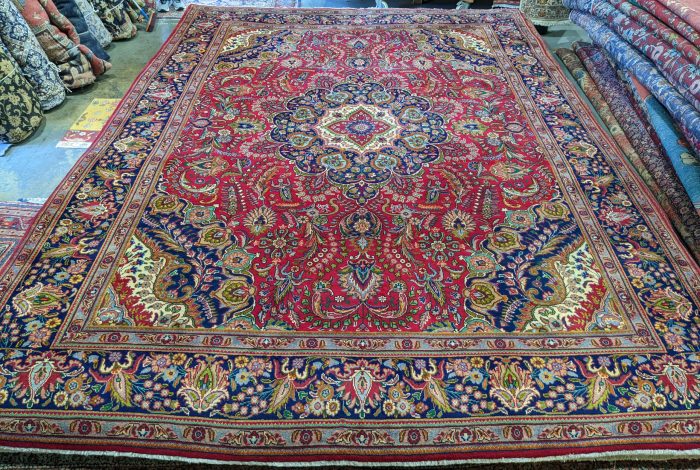Antique Persian Tabriz rugs stand as exquisite testaments to the rich cultural heritage of Persia. With their intricate patterns, vibrant colors, and meticulous craftsmanship, these rugs embody the artistry and tradition that have defined Persian weaving for centuries.
From the ancient techniques used in their creation to the symbolism woven into their designs, Tabriz rugs offer a captivating glimpse into the history and culture of their makers. Their enduring beauty and timeless appeal continue to inspire collectors, designers, and homeowners alike.
History and Origin of Antique Persian Tabriz Rugs
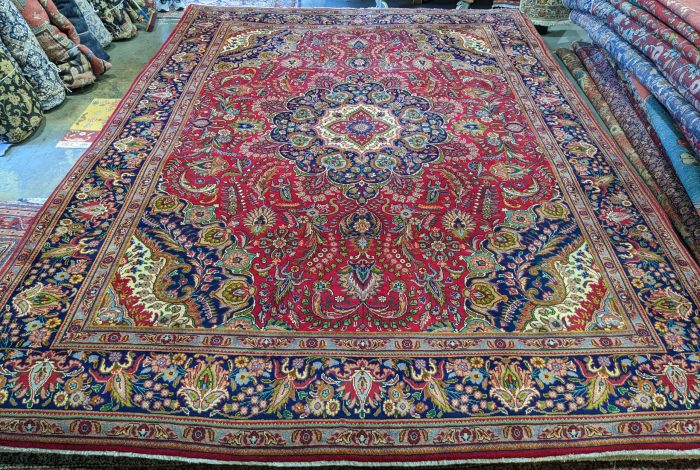
The intricate artistry and cultural significance of antique Persian Tabriz rugs have captivated collectors and enthusiasts for centuries. Woven in the heart of the ancient city of Tabriz, Iran, these rugs embody the rich heritage and exceptional craftsmanship of Persian weaving.
The history of Tabriz rug making can be traced back to the 16th century, during the reign of the Safavid dynasty. Under the patronage of the Safavid rulers, Tabriz became a renowned center for artistic production, including carpet weaving. Skilled artisans developed innovative techniques and employed exquisite materials, creating rugs that were both aesthetically pleasing and durable.
Ancient Weaving Techniques
Antique Persian Tabriz rugs are characterized by their intricate designs and meticulous construction. The weavers employed a variety of traditional techniques, including the Ghiordes knot, which produces a dense and durable pile. The use of natural dyes, such as madder root for red, indigo for blue, and saffron for yellow, resulted in vibrant and long-lasting colors.
Traditional Designs
Tabriz rugs are known for their diverse range of designs, often incorporating floral motifs, geometric patterns, and calligraphic elements. The “Herati” pattern, featuring a repeating diamond-shaped motif, is a classic design often found in Tabriz rugs. Other popular designs include the “Mina Khani,” with its intricate floral patterns, and the “Shah Abbasi,” named after the Safavid ruler who commissioned many of these rugs.
Symbol of Persian Craftsmanship
Antique Persian Tabriz rugs are not only works of art but also symbols of Persian craftsmanship. Their intricate designs, meticulous construction, and enduring beauty have made them highly sought after by collectors worldwide. They represent the cultural heritage and artistic traditions of Iran, showcasing the exceptional skills of Persian weavers.
Design Characteristics of Antique Persian Tabriz Rugs
Antique Persian Tabriz rugs are renowned for their intricate patterns and motifs, showcasing the exceptional craftsmanship and artistic vision of Persian weavers. These rugs are characterized by their use of natural dyes, which impart a rich and vibrant color palette, and by their adherence to traditional design principles.
Intricate Patterns and Motifs
Tabriz rugs feature a vast repertoire of intricate patterns and motifs, often inspired by nature and the surrounding environment. Floral patterns, such as the Herati and Shah Abbasi designs, are common, as are geometric patterns, such as the Boteh (paisley) and Mina Khani (fishhook) motifs.
These patterns are meticulously arranged to create a harmonious and visually captivating composition.
Natural Dyes and Symbolism
Antique Tabriz rugs are renowned for their use of natural dyes, which are derived from plants, insects, and minerals. These dyes produce a rich and vibrant color palette, ranging from deep reds and blues to soft greens and yellows. The colors used in Tabriz rugs often carry symbolic meanings, with red representing passion and courage, blue representing tranquility and wisdom, and green representing fertility and growth.
Sizes and Shapes
Tabriz rugs come in a variety of sizes and shapes, including rectangular, square, and octagonal formats. The most common sizes are 6×9 feet and 9×12 feet, although larger and smaller sizes are also available. Tabriz rugs are traditionally made in a rectangular format, with a central medallion surrounded by a border.
However, some Tabriz rugs feature more elaborate designs, such as all-over patterns or pictorial representations.
Materials and Construction of Antique Persian Tabriz Rugs
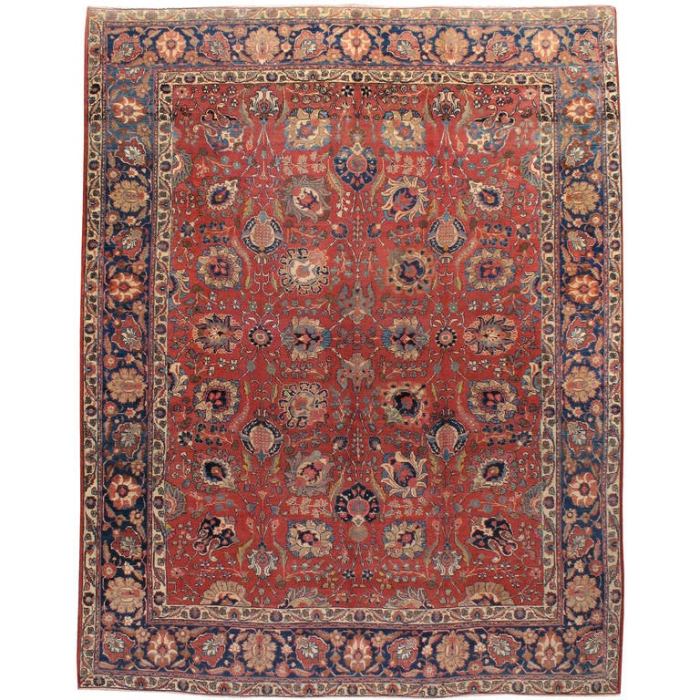
Antique Persian Tabriz rugs are renowned for their exceptional quality, which is attributed to the finest materials and meticulous construction techniques employed by skilled artisans. This section delves into the specific materials used and the intricate craftsmanship that contribute to the durability and aesthetic appeal of these exquisite rugs.
Materials
The foundation of Tabriz rugs is typically made from sturdy cotton or wool, providing a durable base for the intricate pile. The pile, which forms the surface design and texture of the rug, is crafted using high-quality wool or silk.
The wool used in Tabriz rugs is renowned for its softness, luster, and resilience, while the silk adds an element of opulence and sheen.
Knotting Techniques
Tabriz rugs are hand-knotted using a variety of techniques, including the Turkish (or Ghiordes) knot and the Persian (or Senneh) knot. These knots are tightly and evenly spaced, creating a dense and durable pile that can withstand heavy foot traffic and wear over time.
The knot density, measured in knots per square inch (KPSI), is a key indicator of the rug’s quality and value.
Foundation and Pile Construction
The foundation and pile construction of Tabriz rugs play a crucial role in their longevity. The warp and weft threads, which form the foundation, are made from strong cotton or wool and are tightly interlaced to create a stable base for the knots.
The pile is then carefully woven into the foundation using a variety of knotting techniques, resulting in a secure and durable construction.
Collecting and Appraising Antique Persian Tabriz Rugs
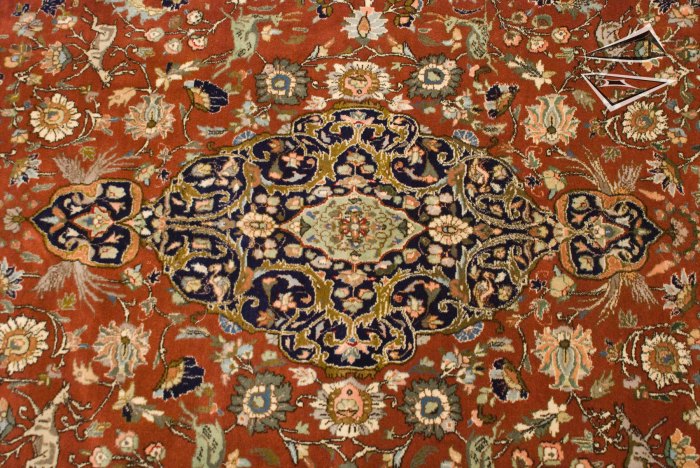
Antique Persian Tabriz rugs are highly sought-after by collectors and investors due to their exquisite craftsmanship, intricate designs, and historical significance. The market value of these rugs can vary significantly depending on various factors, making it crucial for collectors and investors to have a comprehensive understanding of the factors that influence their value.
Antique Persian Tabriz rugs are renowned for their intricate designs and vibrant colors. For those seeking unique and exceptional pieces, first dibs offers a curated selection of these exquisite rugs. Their extensive collection showcases a diverse range of styles and sizes, ensuring that you find the perfect addition to your home décor.
Factors Influencing the Value of Antique Persian Tabriz Rugs
* Age:The age of a Tabriz rug plays a significant role in determining its value. Older rugs are generally more valuable than newer ones, as they are rarer and have had more time to develop a patina.
Condition
The condition of a Tabriz rug is another important factor that affects its value. Rugs that are in good condition, with minimal wear and tear, are more valuable than those that are damaged or heavily worn.
Provenance
The provenance of a Tabriz rug, or its history of ownership, can also impact its value. Rugs with a documented history of ownership by notable collectors or institutions are often more valuable than those with unknown provenance.
Design and Craftsmanship
The design and craftsmanship of a Tabriz rug are also important factors that influence its value. Rugs with intricate and well-executed designs are more valuable than those with simpler designs. Additionally, rugs that are made with high-quality materials and craftsmanship are more valuable than those that are made with lower-quality materials and craftsmanship.
Identifying and Authenticating Antique Persian Tabriz Rugs
Identifying and authenticating antique Persian Tabriz rugs requires a trained eye and a deep understanding of the rugs’ characteristics. Here are a few tips for identifying and authenticating Tabriz rugs:* Examine the knot count:Tabriz rugs are known for their high knot count, which refers to the number of knots per square inch.
A higher knot count indicates a finer and more detailed rug, which is more valuable.
Inspect the materials
Tabriz rugs are typically made with high-quality wool and silk. The wool should be soft and lustrous, and the silk should be smooth and shiny.
Examine the design
Tabriz rugs often feature intricate and detailed designs. The designs are often inspired by nature, and they may include floral motifs, geometric patterns, and animal figures.
Look for signs of age
Antique Tabriz rugs will often show signs of age, such as fading, wear, and repairs. These signs of age can add to the value of the rug, as they indicate that it is a genuine antique.
Interior Design Applications of Antique Persian Tabriz Rugs
Antique Persian Tabriz rugs are versatile works of art that can elevate any interior design scheme. Their intricate designs, rich colors, and luxurious textures make them perfect for adding a touch of sophistication and elegance to any room.
Tabriz rugs can be used in a variety of ways to create different looks. They can be used as statement pieces to define a space, or they can be used as accent pieces to add a touch of color and pattern.
They can also be used to create a sense of warmth and coziness in a room.
Using Tabriz Rugs as Statement Pieces
Tabriz rugs are perfect for creating a statement in a room. Their large size and bold designs make them impossible to ignore. They can be used to define a seating area, or they can be used to create a focal point in a room.
When using a Tabriz rug as a statement piece, it is important to choose a rug that is the right size for the room. The rug should be large enough to make a statement, but it should not be so large that it overwhelms the room.
Using Tabriz Rugs as Accent Pieces
Tabriz rugs can also be used as accent pieces to add a touch of color and pattern to a room. They can be used to add a pop of color to a neutral room, or they can be used to add a touch of pattern to a room with solid-colored walls.
When using a Tabriz rug as an accent piece, it is important to choose a rug that complements the other décor in the room. The rug should not be so bold that it clashes with the other pieces in the room, but it should be bold enough to make a statement.
Tabriz Rugs in Traditional Settings, Antique persian tabriz rug
Tabriz rugs are a natural fit for traditional settings. Their intricate designs and rich colors complement the classic furnishings and décor of traditional homes.
When using a Tabriz rug in a traditional setting, it is important to choose a rug that is in keeping with the style of the room. A rug with a classic design and muted colors will be a good choice for a traditional room.
Tabriz Rugs in Contemporary Settings
Tabriz rugs can also be used in contemporary settings to create a unique and stylish look. Their bold designs and bright colors can add a touch of personality to a contemporary room.
When using a Tabriz rug in a contemporary setting, it is important to choose a rug that is in keeping with the style of the room. A rug with a modern design and bright colors will be a good choice for a contemporary room.
Ultimate Conclusion
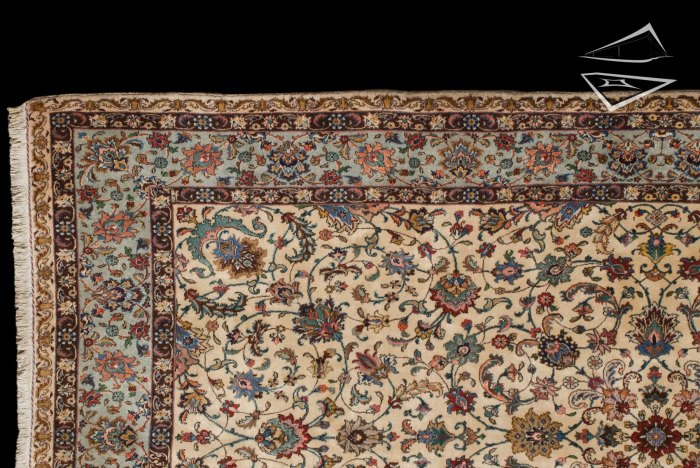
Whether gracing the floors of grand palaces or adding a touch of elegance to contemporary homes, antique Persian Tabriz rugs remain a cherished and enduring symbol of artistic excellence. Their intricate designs, exceptional craftsmanship, and historical significance make them not only valuable investments but also priceless heirlooms to be treasured for generations to come.
